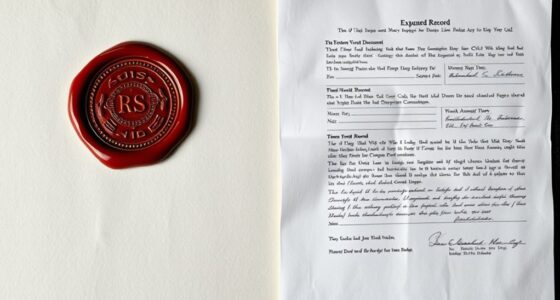Docket numbers are essential for identifying and managing legal cases efficiently. They link all documents, motions, and hearings to the correct case, helping you track case activity and progress over time. These unique identifiers also make it easier to access case records, whether in person or online, though restrictions may apply. Understanding their components and variations across jurisdictions can improve your case organization and research—discover more as you explore further.
Key Takeaways
- Docket numbers serve as unique identifiers that organize and track each case throughout legal proceedings.
- They link all case documents, motions, and hearings, ensuring accurate record-keeping and easy retrieval.
- Docket numbers facilitate efficient case management, monitoring case activity, and maintaining a chronological case history.
- They enable quick access to case information, supporting transparency and legal research accuracy.
- Variations in format across courts highlight the importance of understanding local conventions for proper case identification.
Understanding the Purpose of Docket Numbers
Have you ever wondered how courts keep track of thousands of cases efficiently? Docket numbers serve as a unique identifier assigned to each case, helping courts manage case records smoothly. They guarantee every document, motion, and hearing links correctly to the right case, preventing confusion. The system maintains a detailed, chronological record called a docket sheet, which tracks all case activity. This makes it easy for court staff, attorneys, and parties to locate and retrieve case information quickly. Proper case organization is essential for maintaining accurate records and avoiding misfiling. Without docket numbers, sorting through countless files would be chaotic and error-prone. Their primary purpose is to streamline case management, improve organization, and support accurate record-keeping throughout the entire legal process. This system keeps the courts functioning efficiently and ensures cases are correctly tracked from start to finish. Effective case management relies heavily on the proper use of docket numbers to prevent errors and delays. Proper case tracking systems are essential for maintaining the integrity and efficiency of judicial proceedings. Additionally, the use of docket numbers supports judicial efficiency by enabling faster case retrieval and reducing administrative burdens, thereby enhancing overall court operations.
Components and Formatting of Docket Numbers

What makes docket numbers easy to recognize and use is their standardized format, which typically includes key components arranged in a specific order. This consistency helps you quickly identify and locate case information. The components often include the year of filing, a case type code, a sequential number, and sometimes the judge’s initials. Different courts may vary slightly but follow a similar pattern. To understand the structure better, consider these key points:
- Usually starts with the year of case filing
- Followed by the case type code (e.g., Civ., Cr.)
- Contains a sequential case number
- May include judge’s initials
- Sometimes ends with additional local notes, not part of the official number
- The format often adheres to standardized formatting practices, which are designed to promote consistency and clarity in case management. This uniformity ensures that legal professionals and the public can easily interpret and organize case information without confusion. Additionally, understanding the components of docket numbers can aid in efficient case tracking and retrieval. Recognizing the formatting standards used across different jurisdictions can further streamline the process of case identification and management. Furthermore, these standards facilitate inter-jurisdictional communication by providing a common reference point for case details.
Tracking Legal Proceedings and Case Activity

Your docket number helps you track every step of a case’s progress, from filings to court decisions. It guarantees you can quickly find and verify documents and updates related to the case. By managing the case timeline through docket entries, you stay organized and avoid confusion during legal proceedings. Incorporating case documentation into your records ensures comprehensive oversight of the case’s development. Additionally, understanding online divorce resources can streamline your case management, especially in uncontested divorce situations. Familiarity with legal case management tools can further enhance your ability to monitor case activity efficiently. Recognizing the role of docket numbers in maintaining transparency and accuracy is essential for effective case tracking. Moreover, staying informed about divorce laws and procedural requirements can help prevent delays and ensure compliance throughout the process.
Case Timeline Management
A case timeline is a detailed record of all legal proceedings and activities within a case, allowing courts, attorneys, and parties to monitor progress accurately. Managing this timeline involves tracking every filing, hearing, motion, and order through docket entries. Your role includes:
- Ensuring each activity is correctly recorded with the relevant docket number
- Monitoring filing dates to meet deadlines
- Linking related motions and pleadings for seamless review
- Verifying chronological order to identify procedural gaps
- Using docket entries to locate case documents efficiently
- Maintaining attention to detail to ensure the accuracy and completeness of the case record. Consistent docket number assignment helps maintain a clear and organized case history, which is essential for case timeline management. Additionally, understanding website performance metrics can aid in optimizing case management systems and ensuring efficient access to case information. Being aware of content discoverability strategies can also enhance the accessibility of case records for authorized users.
Filing and Document Tracking
Filing and document tracking are essential components of managing a case’s progress, as they guarantee that every submission, motion, and order is properly recorded and accessible. When you submit documents, including pleadings, motions, or orders, you must include the docket number to ensure they’re linked to the correct case. Courts use docket numbers to organize and index all case activity, making it easier for you, court staff, and other parties to locate relevant records quickly. Whether handling physical files or electronic records, consistent tracking maintains an accurate case history. Accurate case records are vital for a clear understanding of case developments and can influence the outcome of a divorce proceeding. Docket numbers serve as the key reference point for retrieving case documents, verifying filings, and monitoring case developments. Proper tracking minimizes errors, prevents misfiling, and keeps the case timeline clear throughout the entire legal process. Maintaining organized records also supports efficient case management and reduces delays caused by misplaced or incomplete documentation.
Accessibility and Public Availability of Docket Records

You can often access docket records online, making case information more readily available to the public. However, access may be restricted or require fees, especially for sensitive or sealed cases. Understanding these limitations helps you navigate what information is openly accessible and what remains confidential.
Online Access Availability
Have you ever wondered how you can access court docket records online? Many courts now offer electronic systems for public access, making it easier to find case information. These systems often feature:
- Search by case number, party name, or keywords
- Real-time updates on case activity
- Downloadable docket sheets and filings
- Email alerts for new docket entries
- Secure access for authorized users
While many jurisdictions provide free online access, some may charge fees or restrict certain records, especially sealed cases. Access varies widely depending on the court’s technology infrastructure and policies. The convenience of online access permits you to quickly locate case details from anywhere, but always verify the court’s rules to ensure you’re viewing the most current and complete information.
Restrictions and Confidentiality
While online systems have made court records more accessible, legal restrictions and confidentiality rules limit public access to certain docket records. You may find some records fully available, but others are sealed or restricted, especially in sensitive cases like family law, juvenile matters, or criminal proceedings. Courts often restrict access to protect privacy, prevent harassment, or uphold confidentiality agreements. You might need special authorization or court approval to view sealed records. Additionally, some jurisdictions charge fees or require in-person visits for accessing certain dockets. These restrictions aim to balance transparency with privacy concerns. As a user, you should be aware that not all docket information is publicly available, and restrictions vary depending on the case type, court policies, and jurisdictional rules.
Role in Legal Practice and Case Management
How do legal professionals efficiently manage the complexities of case workflows? Docket numbers are essential tools, providing a unique identifier for each case. They streamline case management by enabling quick access, accurate tracking, and clear organization. With a docket number, you can:
- Track every filing, motion, and order related to a case
- Maintain a detailed case timeline and activity history
- Retrieve specific documents from physical or electronic records
- Cross-reference related filings across different courts or jurisdictions
- Ensure accurate communication and avoid misfiling among numerous cases
Using docket numbers helps you stay organized, meet deadlines, and monitor case progress. They serve as the backbone of case management systems, reducing errors and improving efficiency in legal practice.
Variations Across Different Jurisdictions

Different courts and jurisdictions often assign docket numbers using distinct formats and conventions, reflecting their unique procedures and organizational preferences. For example, some courts include the year, case type, and sequential number, while others add judge initials or court codes. These variations can make cross-jurisdiction searches tricky. Here’s a quick comparison:
| Jurisdiction | Format Example | Key Components | Unique Feature | Notes |
|---|---|---|---|---|
| Federal Court | 21-471 | Year, case number | Term year included | Specific to Supreme Court |
| State Court A | 2020-CV-12345 | Year, case type, number | Hyphens separate elements | Common in civil cases |
| State Court B | Cr-001234 | Case type abbreviation, number | No year in docket number | Criminal cases |
| County Court | 2022-001 | Year, sequential number | Minimal info | Local jurisdiction |
| Supreme Court | 21-471 | Term year, case number | Unique for high courts | Standardized across courts |
These differences impact case tracking and record retrieval across jurisdictions.
Limitations and Challenges in Using Docket Numbers

Using docket numbers to identify and track cases can be fraught with challenges because they are assigned independently by various courts, leading to inconsistencies and potential confusion. Different jurisdictions may use varied formats, making it hard to recognize or compare cases across systems. Additionally, similar or identical docket numbers can exist in separate courts, risking misidentification. Some courts destroy or restrict access to older records, limiting historical research. Docket numbers do not reveal case status, location, or jurisdiction without extra context. Local annotations or modifications can further complicate searches or citations. This variability can cause delays, errors, and miscommunication, especially when relying solely on docket numbers for case identification. Ensuring accurate case tracking requires additional identifiers and contextual understanding.
The Impact of Docket Numbers on Legal Research

Docket numbers play a vital role in legal research by serving as precise identifiers that streamline the process of locating case information. When you’re searching for case details, a docket number helps you quickly find all relevant filings, motions, and proceedings associated with a specific case. It acts as a unique key, reducing the risk of confusion with similar cases. Using docket numbers in electronic databases or court records ensures accuracy and efficiency, especially when managing multiple cases. They also assist in verifying case status, procedural history, and jurisdiction. Without them, steering through court records becomes cumbersome and error-prone. Overall, docket numbers are essential tools that enhance the speed, accuracy, and reliability of legal research.
Frequently Asked Questions
Can a Case Have Multiple Docket Numbers in Different Courts?
Yes, a case can have multiple docket numbers in different courts. When a case involves various jurisdictions, appeals, or related proceedings, each court assigns its own unique docket number to track the case within that jurisdiction. You need to look at each court’s docket number separately, as they don’t automatically link across courts. This helps you follow the case’s progress in different courts and manage related filings efficiently.
How Are Emergency or Sealed Cases Assigned Docket Numbers?
Emergency or sealed cases are assigned docket numbers just like regular cases, but with added confidentiality. Courts often keep sealed case numbers hidden from the public, while emergency cases get priority in assignment. You might find these docket numbers through court records or specific access channels. The key is, even sealed or emergency cases receive unique identifiers to guarantee proper tracking, but their details remain protected to preserve confidentiality and security.
Are Docket Numbers Reused After a Case Is Closed?
No, docket numbers are not reused after a case closes. When a case ends, the court typically keeps the docket record for historical purposes, but the number remains assigned to that case only. If a new case with similar details arises, the court assigns a new, unique docket number to avoid confusion. This system helps you accurately track and distinguish cases over time.
Do All Courts Assign Docket Numbers to Small Claims or Minor Cases?
Imagine you’re filing a small claims case about a disputed lawn repair. Not all courts assign docket numbers to minor cases, especially in smaller or local courts. For example, some municipal courts may only assign docket numbers to civil or criminal cases, leaving small claims cases identified by party names or case numbers. Check your court’s procedures beforehand to know if docket numbers are used for your specific case type.
How Can I Verify the Accuracy of a Docket Number?
You verify a docket number’s accuracy by searching the court’s official records or docket system. Enter the number into their online portal or contact the court directly. Check if the case details, such as parties involved, filing date, and case type, match your information. Cross-referencing multiple sources helps confirm the number’s accuracy, ensuring you’re referencing the correct case without errors.
Conclusion
Understanding docket numbers helps you stay organized and navigate legal proceedings smoothly. They’re like a fingerprint for each case, making tracking easier. However, don’t put all your eggs in one basket—limitations exist, and records can sometimes be hard to access. By mastering their use, you’ll be better equipped to handle case management and legal research. Remember, knowing the ropes can make all the difference—it’s better to be safe than sorry.









